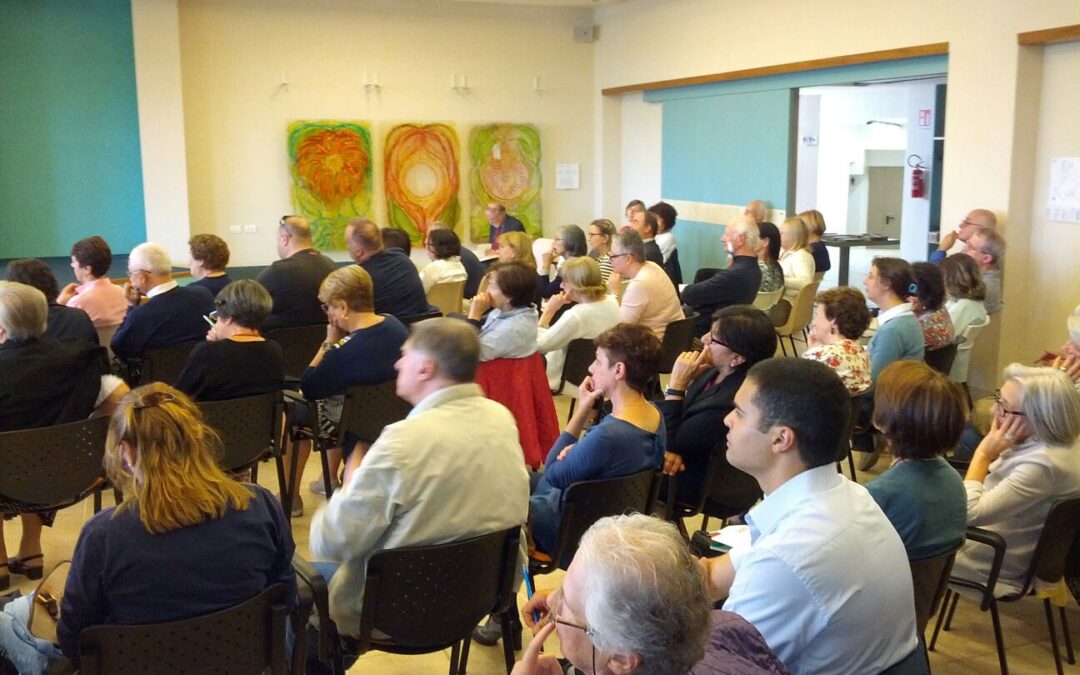
Sep 29, 2017 | Non categorizzato
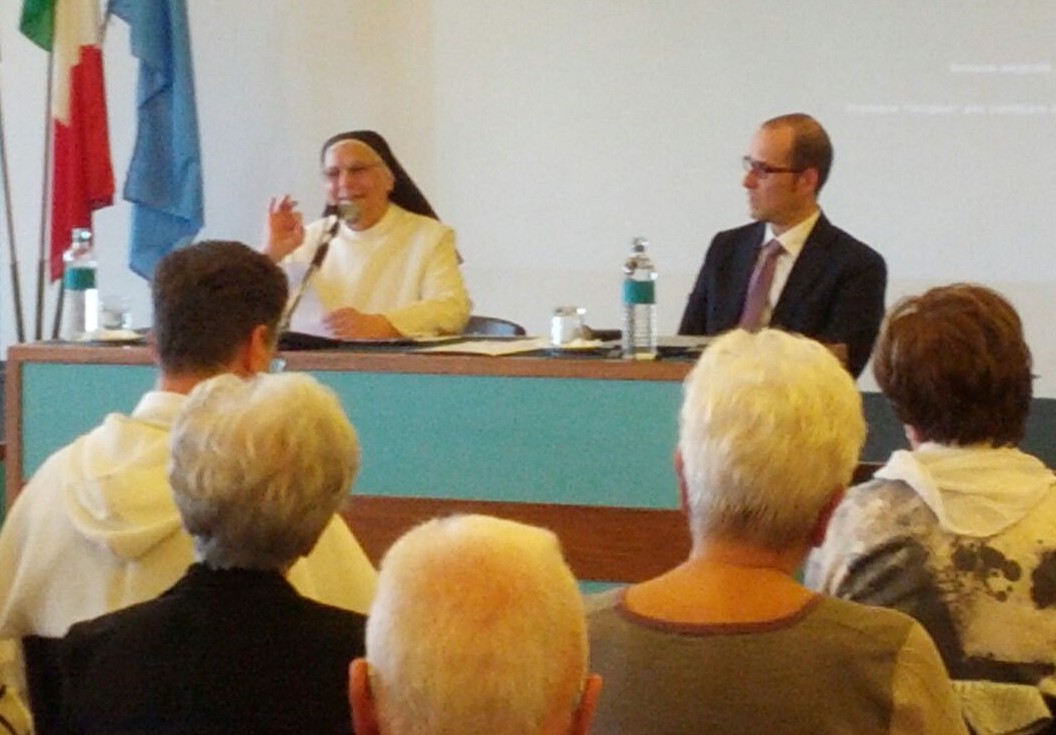 Saturday, 23 September 2017, in the Lecture Hall of the Sophia University Institute (SUI): from the introductory remarks of Mons. Buoncristiani, Archbishop of Siena, and of Maria Voce, President of the Focolare Movement and Vice-Chancellor of the Sophia University Institute, the harmony and the affinity between the two charismatic figures were apparent. These two figures have offered not only the ecclesial space but the whole civil society of their respective periods, an example of a fruitful fusion between spirituality and incarnation, continuously working at the challenges of common living. As Marco Luppi, moderator, opened the conference, he noted the continuity between the proposals of the “happy brigade” of the Catherinites and the spirituality of unity of the Focolare, recalling how various cornerstones of the Saint of Siena’s thought – the uniqueness of the choice of God, the generative value of God’s will, the importance of living the present moment – had been taken up and re-actualized by Chiara Lubich. He recalled that Igino Giordani, co-founder of the Focolare Movement, had initially embarked on the path traced by Caterina’s experience, fascinated by the demonstration of holiness within reach of everyone and the message of universality in her proposal of the Christian choice. The famous connection, “I – my brother – God,” was promoted by Giordani as a fruitful process of interrelation that completes the anthropological dimension with a spiritual openness to divine paternity in Christian meaning. The focal point of the conference was the two main discourses. Sister Elena Ascoli O.P., with her theme “The mysticism of the encounter,” retraced the intimate and concrete dimension of the “mysticism of fire” in Catherine. Christian hope, in the Saint of Siena, becomes a real vocational path in the search for the meaning of living at the service of society and of the Church. 381 letters and numerous collections of hymns and prayers make Catherine the saint of the encounter and of dialogue, animated by the awareness of those who find that the “inner fire,” the relationship with God, represents a patrimony that multiplies its value if it is given, if it builds a relational dynamic of concrete love to one’s neighbour, and if it contributes to the building of associated living in the search for the common good.
Saturday, 23 September 2017, in the Lecture Hall of the Sophia University Institute (SUI): from the introductory remarks of Mons. Buoncristiani, Archbishop of Siena, and of Maria Voce, President of the Focolare Movement and Vice-Chancellor of the Sophia University Institute, the harmony and the affinity between the two charismatic figures were apparent. These two figures have offered not only the ecclesial space but the whole civil society of their respective periods, an example of a fruitful fusion between spirituality and incarnation, continuously working at the challenges of common living. As Marco Luppi, moderator, opened the conference, he noted the continuity between the proposals of the “happy brigade” of the Catherinites and the spirituality of unity of the Focolare, recalling how various cornerstones of the Saint of Siena’s thought – the uniqueness of the choice of God, the generative value of God’s will, the importance of living the present moment – had been taken up and re-actualized by Chiara Lubich. He recalled that Igino Giordani, co-founder of the Focolare Movement, had initially embarked on the path traced by Caterina’s experience, fascinated by the demonstration of holiness within reach of everyone and the message of universality in her proposal of the Christian choice. The famous connection, “I – my brother – God,” was promoted by Giordani as a fruitful process of interrelation that completes the anthropological dimension with a spiritual openness to divine paternity in Christian meaning. The focal point of the conference was the two main discourses. Sister Elena Ascoli O.P., with her theme “The mysticism of the encounter,” retraced the intimate and concrete dimension of the “mysticism of fire” in Catherine. Christian hope, in the Saint of Siena, becomes a real vocational path in the search for the meaning of living at the service of society and of the Church. 381 letters and numerous collections of hymns and prayers make Catherine the saint of the encounter and of dialogue, animated by the awareness of those who find that the “inner fire,” the relationship with God, represents a patrimony that multiplies its value if it is given, if it builds a relational dynamic of concrete love to one’s neighbour, and if it contributes to the building of associated living in the search for the common good.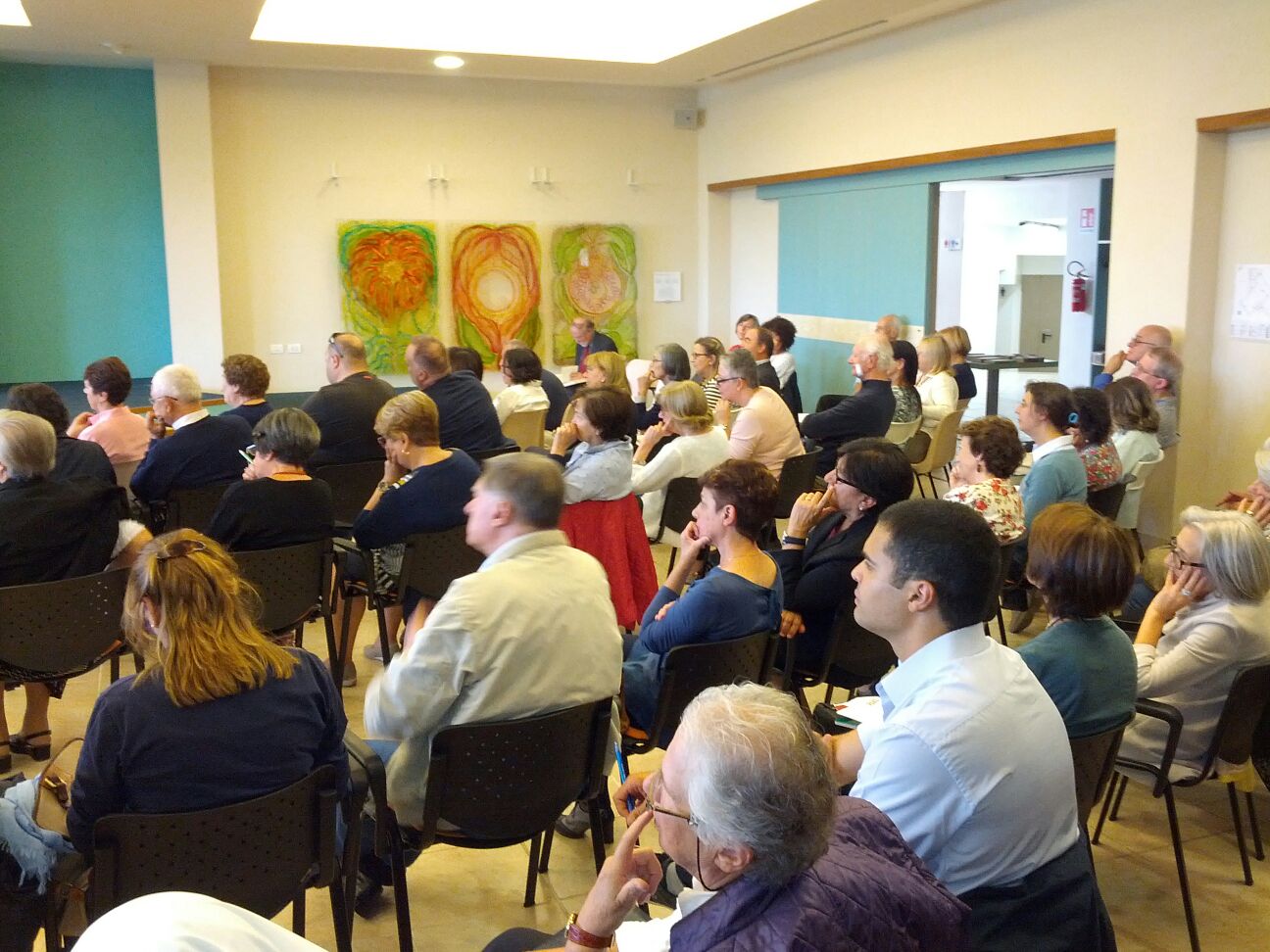 Piero Coda, president of Sophia, in his report titled “Real Love and the One True Love,” proposed an original reading of the generative encounter between the Franciscan roots of Chiara Lubich and the Catherinite period of Giordani, an encounter which reflects an experience of Christian renewal in the foundational period of the Focolare Movement, capable of giving life to a new reality in the Church and in society. The “pact” between charisms generates an originality that emphasises the dynamism of reciprocity as a sounding board for the dimension of unity and becomes the fulcrum of a proposal at the service of humanity. The “mysticism of fire” in Chiara Lubich, recovered by Coda in some passages of her writing, “The Resurrection of Rome,” reminds us how the impetus of inner, individual momentum flourishes in the community dynamics: “It is God who makes two people one, placing himself as the third in a relationship between them: Jesus among us.” In closing, the speech by Dr. Aldo Bernabei, representative of the Roman group of the Catherinites, traced the joint path between his association and the Focolare Movement in the multi-decade animation of the project “Together for Europe,” a demonstration that works steadily to build a European spirit that recognises the Christian soul among its foundation values, a path that joins more than 500 churches, movements, communities and associations.
Piero Coda, president of Sophia, in his report titled “Real Love and the One True Love,” proposed an original reading of the generative encounter between the Franciscan roots of Chiara Lubich and the Catherinite period of Giordani, an encounter which reflects an experience of Christian renewal in the foundational period of the Focolare Movement, capable of giving life to a new reality in the Church and in society. The “pact” between charisms generates an originality that emphasises the dynamism of reciprocity as a sounding board for the dimension of unity and becomes the fulcrum of a proposal at the service of humanity. The “mysticism of fire” in Chiara Lubich, recovered by Coda in some passages of her writing, “The Resurrection of Rome,” reminds us how the impetus of inner, individual momentum flourishes in the community dynamics: “It is God who makes two people one, placing himself as the third in a relationship between them: Jesus among us.” In closing, the speech by Dr. Aldo Bernabei, representative of the Roman group of the Catherinites, traced the joint path between his association and the Focolare Movement in the multi-decade animation of the project “Together for Europe,” a demonstration that works steadily to build a European spirit that recognises the Christian soul among its foundation values, a path that joins more than 500 churches, movements, communities and associations.
Sep 28, 2017 | Non categorizzato, Word of
While St. Paul was in prison on account of his preaching, he wrote to the Christian community in the city of Philippi. He had been the very first to preach the Gospel there, and many people had come to believe and had committed themselves generously to this new life. Even after Paul had left them, they continued to bear witness to Christian love. Knowing this about them made him very happy, which is why his letter is full of affection for the Philippians. Paul encouraged them, therefore, to go ahead and to grow both as individuals and as a community. For this reason he reminded them of their model Jesus, who they should learn from. “Let the same mind be in you that was in Christ Jesus.” What is this “mind”? How can we know the deepest desires Jesus had so as to imitate him? Paul understood how: Jesus Christ, the Son of God, had emptied himself and had come down among us. He became man and was completely at the service of the Father, so that we could become children of God. Paul told the Galatians about this, saying, “And because you are children, God has sent the Spirit of his Son into our hearts, crying, ‘Abba! Father!’” (Gal 4:6). And in fact, John had already written about it in his Gospel: “But to all who received him, who believed in his name, he gave power to become children of God” (Jn 1:12). Jesus had fulfilled his mission through the way he lived his whole life. He continually humbled himself so as to reach those who were the smallest, weakest or most insecure: lepers, widows, strangers or sinners. He raised them up; making them feel loved and saved at last. “Let the same mind be in you that was in Christ Jesus.” In order to recognize and cultivate the mind of Jesus in us, let’s first be aware of his love and the power of his forgiveness. Let’s look to him, making his way of acting our own. It urges us to open our hearts, our minds and our arms to welcome each person just as they are. Let’s avoid making any judgements about others, but allow ourselves instead to be enriched by all that is positive in those we meet, even when it may be hidden in a pile of wretchedness and errors so that it seems to us a “waste of time” looking for it. The strongest desire in the mind of Jesus, which we can make our own, is love freely given, the willingness to be at the service of others with our talents, whether great or small, and to courageously and positively build up good relationships wherever we are. This love knows how to face difficulties, misunderstandings and differences with a gentle spirit, determined to find the ways of dialogue and mutual agreement. “Let the same mind be in you that was in Christ Jesus.” Chiara Lubich let the Gospel guide her entire life, and she experienced its power. In 1982, she wrote, “Imitating Jesus means understanding that we Christians only make sense if we live for others, if we think of our existence as a service for our brothers and sister, if we organize our lives on this basis.” “Then we fulfill what Jesus has most at heart. We will have fully grasped the Gospel. And we will be truly blessed.” Letizia Magri
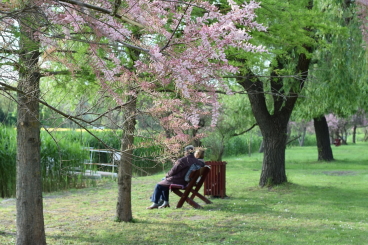
Sep 28, 2017 | Non categorizzato
 When my husband John was diagnosed with Alzheimer’s my life changed dramatically. I felt really frightened because there were times when he was hallucinating all night. I had no medication to give him, I wasn’t managing and there was no-one to turn to. John’s care manager was on maternity leave, the psychiatrist had discharged him, the GP was on holiday. After a lot of phone calls John’s new care manager placed him into respite care for a week. I wasn’t coping anymore. I didn’t feel up to the task of being his main carer and I was angry that things had deteriorated to that point. There was so much to do and finances to sort out. I was going downhill and my health was deteriorating. In the New Year I went to the HELP shop in the town and was told that a Carer Support Worker would contact me. It was about four weeks later that she came to see me. I told her everything and she understood. She was very sympathetic, helpful and supportive. A few weeks after this I went to a four-day meeting with people from the Focolare and my husband went into respite care. One evening I was with a group of about ten people and someone said, ‘What do you do Pam?’ I didn’t want to tell her anything so I ignored her question because I didn’t want everyone to know how I struggled and how weak and helpless I felt. But then I thought how rude I was because I would be very upset if someone ignored me when I asked them a question. I started telling the group how it was and when it came to the bit where I went to the HELP shop, I started crying. There was such a change in the dynamics even though I didn’t want attention at a time like this. Everyone was warm, caring and loving and tried to comfort me. They understood my misery and they loved me, they had compassion for me. I thought I would feel ashamed after my outburst but I told myself that these things happen and the great thing is I felt the burden had lifted and I had been healed. It was a grace that God had given me to help me with my difficulties. My situation hadn’t changed but I had. Looking after my husband had become the most important thing in my life but it had become a burden. Didn’t Jesus say, ‘My yoke is easy and my burden is light’? I needed to be reminded that God loved me immensely. Once I put God in the first place in my heart, mind and soul then everything was put into perspective. It was no longer a burden and I became confident looking after him. Some people advise that in situations like this we should pray more. This is true but what helped me in that moment was the presence of Jesus in that group who enabled me to experience the love of God. Now I know that I can count on everyone’s love as my experience with John continued to unfold. Source: New City Magazine (UK), August-September 2017 issue
When my husband John was diagnosed with Alzheimer’s my life changed dramatically. I felt really frightened because there were times when he was hallucinating all night. I had no medication to give him, I wasn’t managing and there was no-one to turn to. John’s care manager was on maternity leave, the psychiatrist had discharged him, the GP was on holiday. After a lot of phone calls John’s new care manager placed him into respite care for a week. I wasn’t coping anymore. I didn’t feel up to the task of being his main carer and I was angry that things had deteriorated to that point. There was so much to do and finances to sort out. I was going downhill and my health was deteriorating. In the New Year I went to the HELP shop in the town and was told that a Carer Support Worker would contact me. It was about four weeks later that she came to see me. I told her everything and she understood. She was very sympathetic, helpful and supportive. A few weeks after this I went to a four-day meeting with people from the Focolare and my husband went into respite care. One evening I was with a group of about ten people and someone said, ‘What do you do Pam?’ I didn’t want to tell her anything so I ignored her question because I didn’t want everyone to know how I struggled and how weak and helpless I felt. But then I thought how rude I was because I would be very upset if someone ignored me when I asked them a question. I started telling the group how it was and when it came to the bit where I went to the HELP shop, I started crying. There was such a change in the dynamics even though I didn’t want attention at a time like this. Everyone was warm, caring and loving and tried to comfort me. They understood my misery and they loved me, they had compassion for me. I thought I would feel ashamed after my outburst but I told myself that these things happen and the great thing is I felt the burden had lifted and I had been healed. It was a grace that God had given me to help me with my difficulties. My situation hadn’t changed but I had. Looking after my husband had become the most important thing in my life but it had become a burden. Didn’t Jesus say, ‘My yoke is easy and my burden is light’? I needed to be reminded that God loved me immensely. Once I put God in the first place in my heart, mind and soul then everything was put into perspective. It was no longer a burden and I became confident looking after him. Some people advise that in situations like this we should pray more. This is true but what helped me in that moment was the presence of Jesus in that group who enabled me to experience the love of God. Now I know that I can count on everyone’s love as my experience with John continued to unfold. Source: New City Magazine (UK), August-September 2017 issue
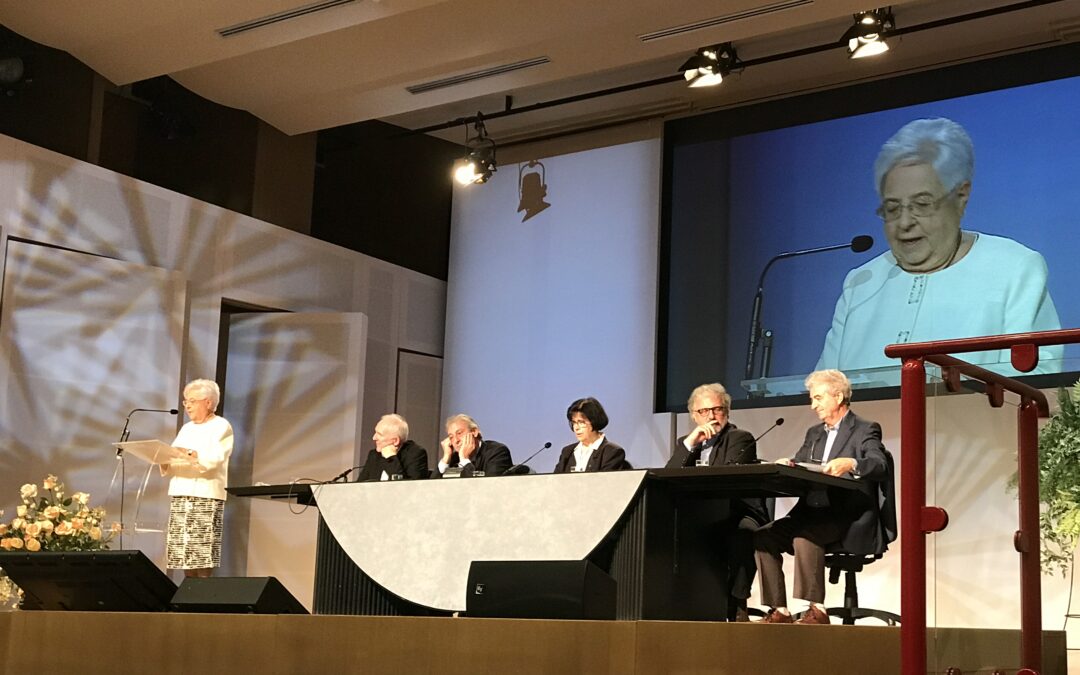
Sep 27, 2017 | Non categorizzato
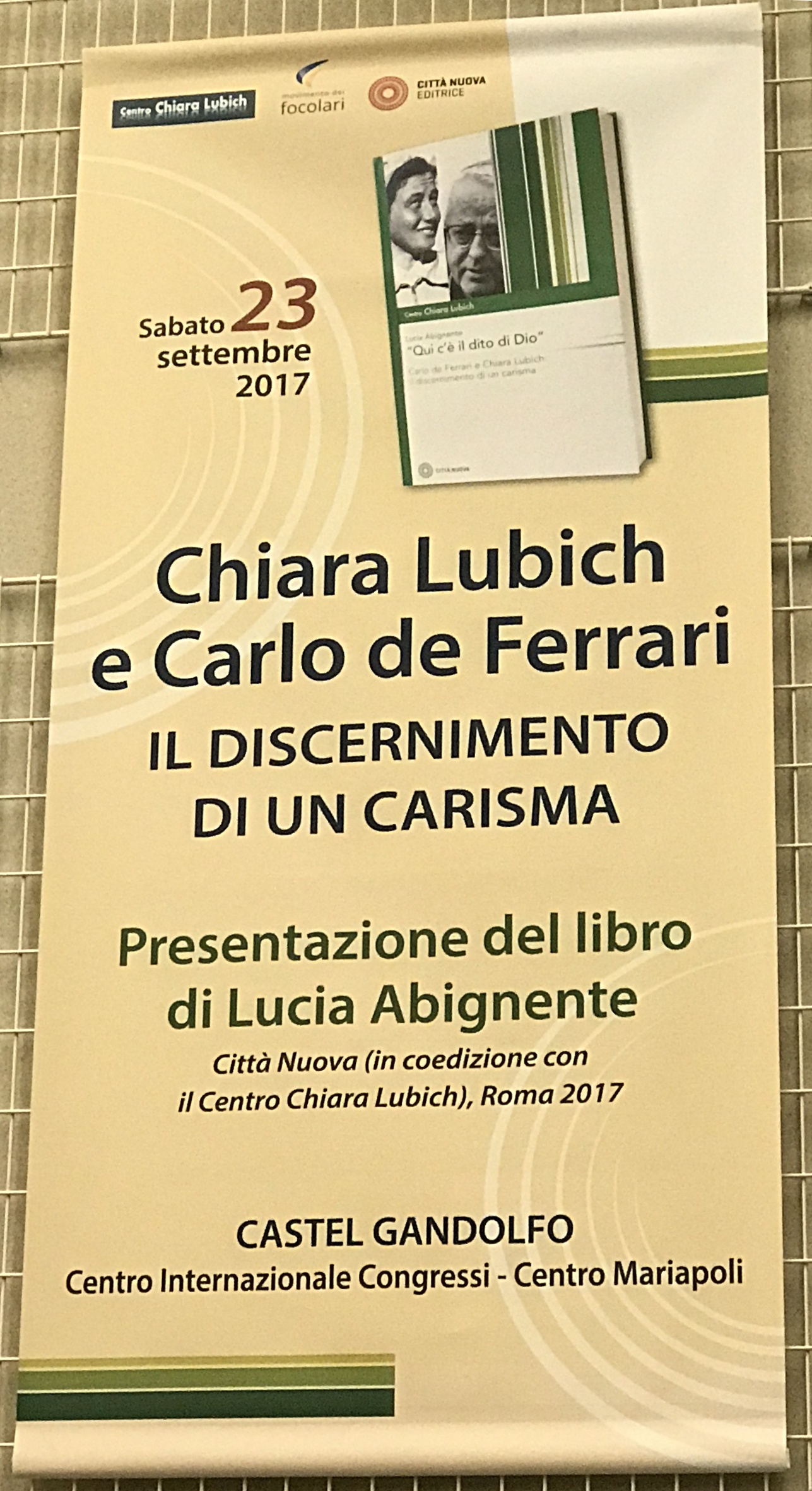 I am delighted to have the opportunity to greet all those attending the launch of the book:Qui c’è il dito di Dio” (“Here is the hand of God”). It is the second volume in the series “Studies and Documents” published by the Chiara Lubich Centre. The title of the book recalls words well known to the members of the Focolare Movement. They were spoken by the Archbishop of Trent, Most Rev. Carlo de Ferrari, who recognised that the new life coming about in his diocese, which was both edifying and opposed at the same time, did not come from human beings but “from the hand of God”. Clear insight allowed this pastor not to be influenced by judgements and considerations that were purely “human” but to enter more deeply into the surprising action of God made manifest through the life of a group of young women. All this took place 20 years before the Second Vatican Council, and history proved him right. As members of the Focolare Movement, we feel special gratitude to Archbishop De Ferrari for his wise discernment, which allowed the little fire that was burning to grow and later spread throughout the world. Looking back after 70 years, this work by Lucia Abignente helps us understand the extent to which the Archbishop’s perception was deeply rooted in the life of the Word of God and his action imbued with humility, perseverance, readiness to pay the price in person, and with prophecy. In reconstructing the events, which in this volume are derived from a multitude of sources, we can discover a golden thread. Both favourable and adverse circumstances allowed Chiara Lubich and “her” bishop to forge a relationship of communion that was living, and real. This relationship gave meaning to the alternating times of “hosanna” and “crucifixion” – to use words we find in their letters – and enabled Chiara to live out of love for God and the Church. These pages offer us an authentic and engaging witness to this love.
I am delighted to have the opportunity to greet all those attending the launch of the book:Qui c’è il dito di Dio” (“Here is the hand of God”). It is the second volume in the series “Studies and Documents” published by the Chiara Lubich Centre. The title of the book recalls words well known to the members of the Focolare Movement. They were spoken by the Archbishop of Trent, Most Rev. Carlo de Ferrari, who recognised that the new life coming about in his diocese, which was both edifying and opposed at the same time, did not come from human beings but “from the hand of God”. Clear insight allowed this pastor not to be influenced by judgements and considerations that were purely “human” but to enter more deeply into the surprising action of God made manifest through the life of a group of young women. All this took place 20 years before the Second Vatican Council, and history proved him right. As members of the Focolare Movement, we feel special gratitude to Archbishop De Ferrari for his wise discernment, which allowed the little fire that was burning to grow and later spread throughout the world. Looking back after 70 years, this work by Lucia Abignente helps us understand the extent to which the Archbishop’s perception was deeply rooted in the life of the Word of God and his action imbued with humility, perseverance, readiness to pay the price in person, and with prophecy. In reconstructing the events, which in this volume are derived from a multitude of sources, we can discover a golden thread. Both favourable and adverse circumstances allowed Chiara Lubich and “her” bishop to forge a relationship of communion that was living, and real. This relationship gave meaning to the alternating times of “hosanna” and “crucifixion” – to use words we find in their letters – and enabled Chiara to live out of love for God and the Church. These pages offer us an authentic and engaging witness to this love. 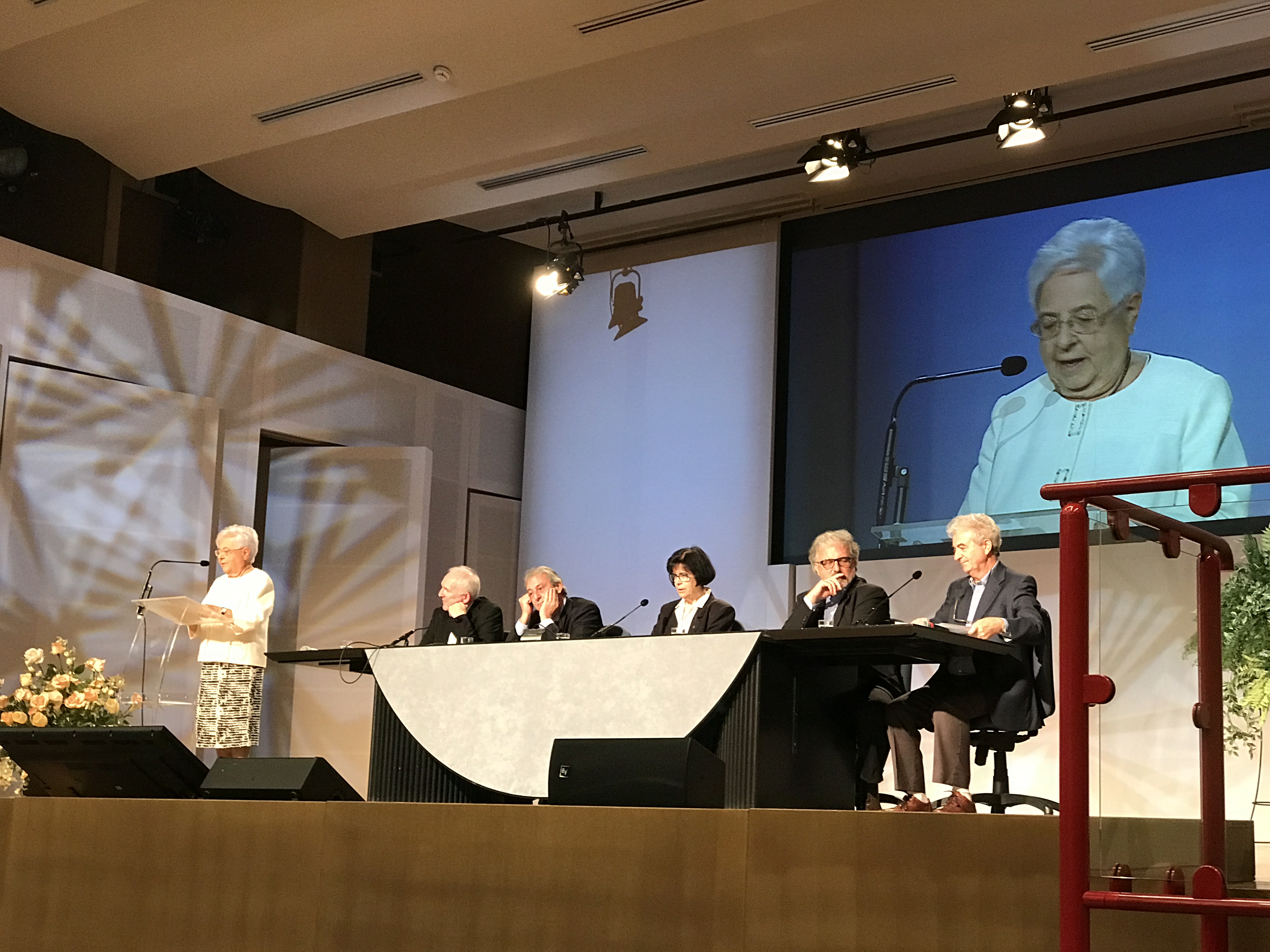 Today in addition, this witness represents an invitation to us to be newly aware of the gift of the charism we have received and of the potential of a foundation that, as is recognised today, opened up a pathway followed by other ecclesial realities. I am glad to note that the publication of this book occurs in the year the Focolare Movement is dedicating to deepening our understanding of Mary. Mary who represents one of the key points of the spirituality of unity. It was during the period of light lived during the summer of 1949 (in which the Holy Spirit enabled Chiara to contemplate the greatness of the Mother of God and to admire her in her unique beauty, all clothed with the Word of God) that God’s plan for the new Movement itself became clear; it was the Work of Mary. The “marian” vocation and hallmark of this Work are evident in these pages and given unconfutable proof – I would say – thanks to Chiara’s perennial renewal of her yes to God’s plans. Chiara said yes to her calling, yes to proclaiming the Ideal that imbued her whole life, yes to her readiness to offer and sacrifice the fruit born from it, during the years when the Movement was studied by the Church of Rome. In Mary’s “let it be” at the Annunciation, and in her yes in desolation at the foot of the cross, she is the model, the mould in which Chiara lived her divine adventure. In our time, there is “a new and more explicit awareness of the Marian principle in the Church, as a sacrament of unity”. I trust that the witness and the message conveyed by the book launched today, may be a gift for the whole people of God and help the Work of Mary to express the vocation that the Church confirmed in the Statutes: to be “as far as possible – a presence of Mary on earth and “almost” a continuation of her”.
Today in addition, this witness represents an invitation to us to be newly aware of the gift of the charism we have received and of the potential of a foundation that, as is recognised today, opened up a pathway followed by other ecclesial realities. I am glad to note that the publication of this book occurs in the year the Focolare Movement is dedicating to deepening our understanding of Mary. Mary who represents one of the key points of the spirituality of unity. It was during the period of light lived during the summer of 1949 (in which the Holy Spirit enabled Chiara to contemplate the greatness of the Mother of God and to admire her in her unique beauty, all clothed with the Word of God) that God’s plan for the new Movement itself became clear; it was the Work of Mary. The “marian” vocation and hallmark of this Work are evident in these pages and given unconfutable proof – I would say – thanks to Chiara’s perennial renewal of her yes to God’s plans. Chiara said yes to her calling, yes to proclaiming the Ideal that imbued her whole life, yes to her readiness to offer and sacrifice the fruit born from it, during the years when the Movement was studied by the Church of Rome. In Mary’s “let it be” at the Annunciation, and in her yes in desolation at the foot of the cross, she is the model, the mould in which Chiara lived her divine adventure. In our time, there is “a new and more explicit awareness of the Marian principle in the Church, as a sacrament of unity”. I trust that the witness and the message conveyed by the book launched today, may be a gift for the whole people of God and help the Work of Mary to express the vocation that the Church confirmed in the Statutes: to be “as far as possible – a presence of Mary on earth and “almost” a continuation of her”.
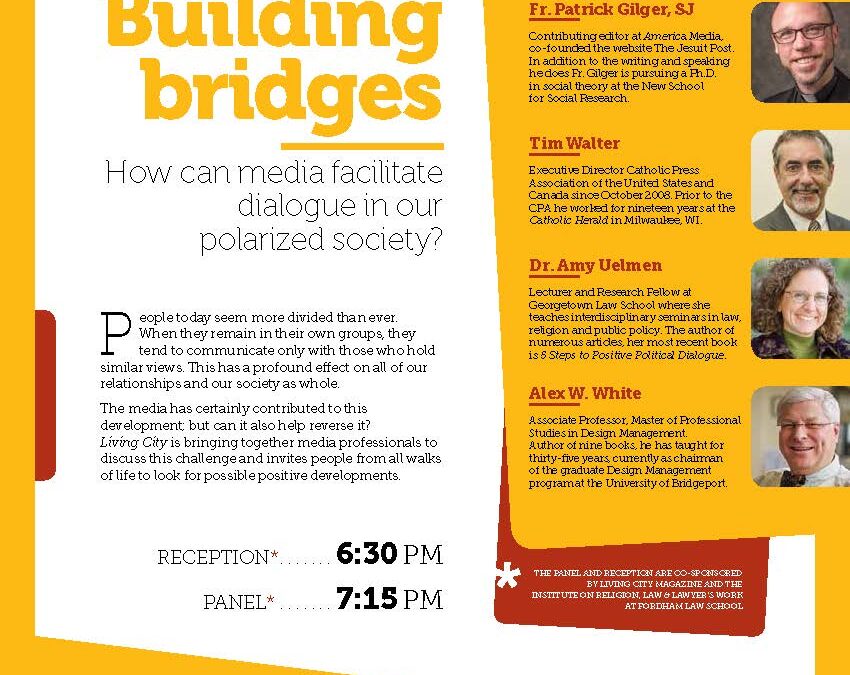
Sep 27, 2017 | Focolare Worldwide
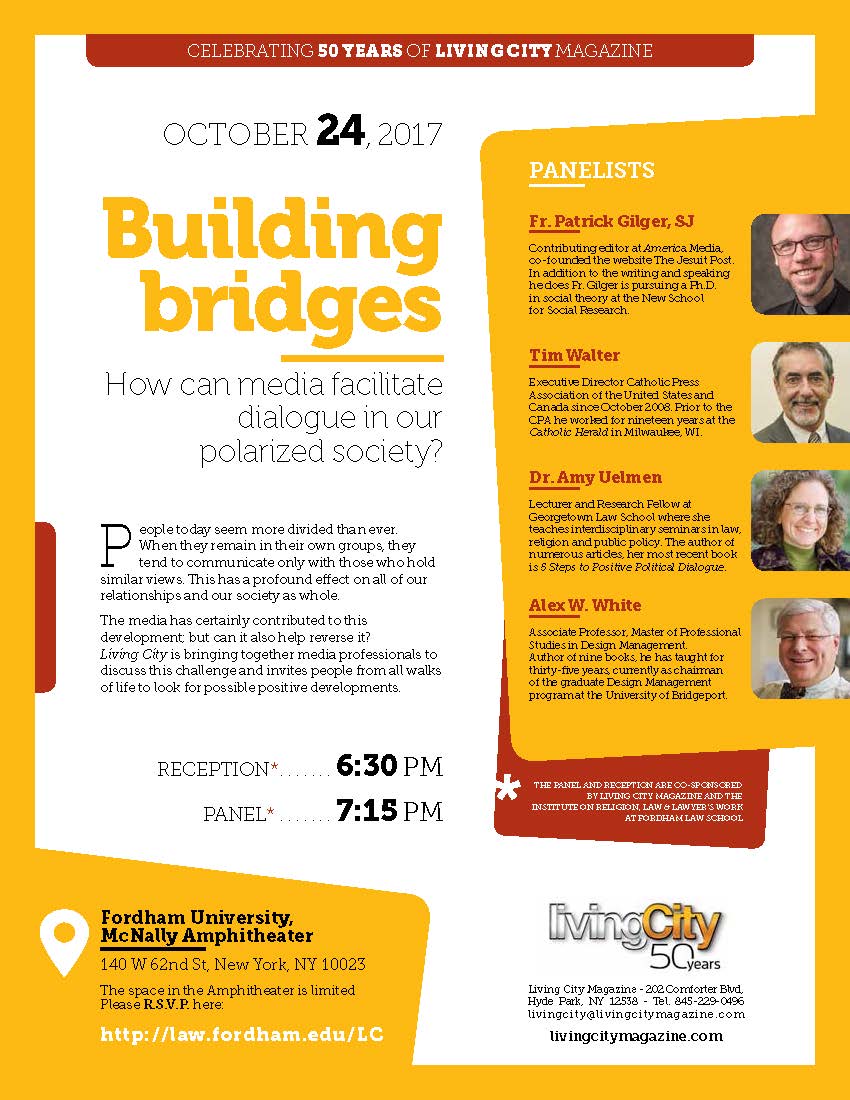 To celebrate its 50 years of activity, the English language magazine, founded in 1967 in New York as one of the 32 editions of the Focolare Movement, held a conference on 24 September entitled, “Building bridges: how can media facilitate dialogue in our polarised society?” at Fordham University in New York, with the contribution of professors and journalists. Living City is read and appreciated not only in the United States, but also in Canada, Australia, Ireland, Malta, New Zealand and many other English-speaking countries. Its readers are people of all ages and religious convictions. Recently it was awarded 5 prizes by the Catholic Press Association of North America.
To celebrate its 50 years of activity, the English language magazine, founded in 1967 in New York as one of the 32 editions of the Focolare Movement, held a conference on 24 September entitled, “Building bridges: how can media facilitate dialogue in our polarised society?” at Fordham University in New York, with the contribution of professors and journalists. Living City is read and appreciated not only in the United States, but also in Canada, Australia, Ireland, Malta, New Zealand and many other English-speaking countries. Its readers are people of all ages and religious convictions. Recently it was awarded 5 prizes by the Catholic Press Association of North America.

 Saturday, 23 September 2017, in the Lecture Hall of the Sophia University Institute (SUI): from the introductory remarks of Mons. Buoncristiani, Archbishop of Siena, and of Maria Voce, President of the Focolare Movement and Vice-Chancellor of the Sophia University Institute, the harmony and the affinity between the two charismatic figures were apparent. These two figures have offered not only the ecclesial space but the whole civil society of their respective periods, an example of a fruitful fusion between spirituality and incarnation, continuously working at the challenges of common living. As Marco Luppi, moderator, opened the conference, he noted the continuity between the proposals of the “happy brigade” of the Catherinites and the spirituality of unity of the Focolare, recalling how various cornerstones of the Saint of Siena’s thought – the uniqueness of the choice of God, the generative value of God’s will, the importance of living the present moment – had been taken up and re-actualized by Chiara Lubich. He recalled that Igino Giordani, co-founder of the Focolare Movement, had initially embarked on the path traced by Caterina’s experience, fascinated by the demonstration of holiness within reach of everyone and the message of universality in her proposal of the Christian choice. The famous connection, “I – my brother – God,” was promoted by Giordani as a fruitful process of interrelation that completes the anthropological dimension with a spiritual openness to divine paternity in Christian meaning. The focal point of the conference was the two main discourses. Sister Elena Ascoli O.P., with her theme “The mysticism of the encounter,” retraced the intimate and concrete dimension of the “mysticism of fire” in Catherine. Christian hope, in the Saint of Siena, becomes a real vocational path in the search for the meaning of living at the service of society and of the Church. 381 letters and numerous collections of hymns and prayers make Catherine the saint of the encounter and of dialogue, animated by the awareness of those who find that the “inner fire,” the relationship with God, represents a patrimony that multiplies its value if it is given, if it builds a relational dynamic of concrete love to one’s neighbour, and if it contributes to the building of associated living in the search for the common good.
Saturday, 23 September 2017, in the Lecture Hall of the Sophia University Institute (SUI): from the introductory remarks of Mons. Buoncristiani, Archbishop of Siena, and of Maria Voce, President of the Focolare Movement and Vice-Chancellor of the Sophia University Institute, the harmony and the affinity between the two charismatic figures were apparent. These two figures have offered not only the ecclesial space but the whole civil society of their respective periods, an example of a fruitful fusion between spirituality and incarnation, continuously working at the challenges of common living. As Marco Luppi, moderator, opened the conference, he noted the continuity between the proposals of the “happy brigade” of the Catherinites and the spirituality of unity of the Focolare, recalling how various cornerstones of the Saint of Siena’s thought – the uniqueness of the choice of God, the generative value of God’s will, the importance of living the present moment – had been taken up and re-actualized by Chiara Lubich. He recalled that Igino Giordani, co-founder of the Focolare Movement, had initially embarked on the path traced by Caterina’s experience, fascinated by the demonstration of holiness within reach of everyone and the message of universality in her proposal of the Christian choice. The famous connection, “I – my brother – God,” was promoted by Giordani as a fruitful process of interrelation that completes the anthropological dimension with a spiritual openness to divine paternity in Christian meaning. The focal point of the conference was the two main discourses. Sister Elena Ascoli O.P., with her theme “The mysticism of the encounter,” retraced the intimate and concrete dimension of the “mysticism of fire” in Catherine. Christian hope, in the Saint of Siena, becomes a real vocational path in the search for the meaning of living at the service of society and of the Church. 381 letters and numerous collections of hymns and prayers make Catherine the saint of the encounter and of dialogue, animated by the awareness of those who find that the “inner fire,” the relationship with God, represents a patrimony that multiplies its value if it is given, if it builds a relational dynamic of concrete love to one’s neighbour, and if it contributes to the building of associated living in the search for the common good. Piero Coda, president of Sophia, in his report titled “Real Love and the One True Love,” proposed an original reading of the generative encounter between the Franciscan roots of Chiara Lubich and the Catherinite period of Giordani, an encounter which reflects an experience of Christian renewal in the foundational period of the Focolare Movement, capable of giving life to a new reality in the Church and in society. The “pact” between charisms generates an originality that emphasises the dynamism of reciprocity as a sounding board for the dimension of unity and becomes the fulcrum of a proposal at the service of humanity. The “mysticism of fire” in Chiara Lubich, recovered by Coda in some passages of her writing, “The Resurrection of Rome,” reminds us how the impetus of inner, individual momentum flourishes in the community dynamics: “It is God who makes two people one, placing himself as the third in a relationship between them: Jesus among us.” In closing, the speech by Dr. Aldo Bernabei, representative of the Roman group of the Catherinites, traced the joint path between his association and the Focolare Movement in the multi-decade animation of the project “Together for Europe,” a demonstration that works steadily to build a European spirit that recognises the Christian soul among its foundation values, a path that joins more than 500 churches, movements, communities and associations.
Piero Coda, president of Sophia, in his report titled “Real Love and the One True Love,” proposed an original reading of the generative encounter between the Franciscan roots of Chiara Lubich and the Catherinite period of Giordani, an encounter which reflects an experience of Christian renewal in the foundational period of the Focolare Movement, capable of giving life to a new reality in the Church and in society. The “pact” between charisms generates an originality that emphasises the dynamism of reciprocity as a sounding board for the dimension of unity and becomes the fulcrum of a proposal at the service of humanity. The “mysticism of fire” in Chiara Lubich, recovered by Coda in some passages of her writing, “The Resurrection of Rome,” reminds us how the impetus of inner, individual momentum flourishes in the community dynamics: “It is God who makes two people one, placing himself as the third in a relationship between them: Jesus among us.” In closing, the speech by Dr. Aldo Bernabei, representative of the Roman group of the Catherinites, traced the joint path between his association and the Focolare Movement in the multi-decade animation of the project “Together for Europe,” a demonstration that works steadily to build a European spirit that recognises the Christian soul among its foundation values, a path that joins more than 500 churches, movements, communities and associations.





